In the face of a painful and debilitating disease, many arthritis sufferers struggle to stay physically active, even though exercise can make their symptoms less severe.
The act of walking itself may be the biggest barrier to getting these patients moving, said Kharma Foucher, S.B. ’96.
Foucher, Assistant Professor at the University of Illinois at Chicago (UIC), studies gait mechanics in an effort to help reduce pain and improve function for knee and hip osteoarthritis patients.
“Some people with arthritis are afraid to exercise because they think it will worsen their symptoms, so there are some psychological components to it,” she said. “But I hypothesize that there is also a biomechanical component to it, and the compensations people make during gait because of their disease prevent them from being as physically active as they want to be.”
Constant gait compensations can wear people out so they lack the energy to exercise, Foucher explained. She’s currently studying some simple interventions and strengthening protocols that could help patients have more energy to stay active.
Helping patients has been a mission for Foucher since her early childhood in Chicago.
“I remember always being interested in medicine and health care,” she recalled. “When I was a kid, my friends and I would pretend to break bones. I would make casts with toilet paper and water and set all my friends’ bones with that disgusting concoction.”
Throughout elementary, middle, and high school, Foucher spent many summers at science camps, where she was introduced to the rapidly growing field of biomedicine. Fascinated by the concept of the body as a machine, she decided to concentrate in bioengineering at the Harvard John A. Paulson School of Engineering and Applied Sciences.
During a summer internship in a gait mechanics lab in Chicago—her first engineering research experience—Foucher immersed herself in an ankle stiffness research project. She was blown away by the cutting-edge equipment as she learned to gather and analyze data.
That experience inspired Foucher to pursue an M.D./Ph.D. at UIC.
In the orthopedics department, she studied bone loss that occurs around the proximal femur in hip replacement patients. Foucher sought to understand how much of that bone loss occurs due to stress shielding and how much is caused by abnormal walking patterns.
It was a complicated project with a lot of moving parts, and it was difficult to keep things progressing as quickly as she would have liked.
“I really enjoyed working with the people and watching them improve as I followed them during the first few years after surgery,” she said. “That was a really important thing to me—thinking about research from the human perspective—and it grew into the work that I’m doing now.”
After finishing her M.D./Ph.D. in 2008, Foucher accepted a faculty position in the orthopedic surgery department at Rush University Medical Center in Chicago. She continued to study bone loss in total hip replacement patients, but her research started branching out.
Foucher found herself spending more time thinking about what comes before a hip replacement, and that sparked her interest in arthritis and osteoarthritis.
“I wasn’t thinking about my patients as the subjects, or as data points to go into my model anymore. I was thinking about them as full humans,” she said. “I got really interested in how my biomechanical measurements were related to clinical outcomes, and that led me into the direction that I am on now.”
After joining UIC as an Assistant Professor in the Department of Kinesiology and Nutrition in 2013, Foucher began working directly with patients.
In addition to studying physical activity, she is collaborating with computational biomechanics researchers to explore micromotion in the modular parts of an artificial hip. Foucher is interested in how gait can predict the microscopic motions that lead to corrosion and implant failure.
She is also conducting studies to determine why osteoarthritis patients fall more often than others, in the hopes of developing simple interventions to reduce that risk.
Finding patients who will come to the lab for human studies is a constant challenge, but the human element of the research is what Foucher finds most rewarding.
“We already are helping people because they learn a little more about themselves when they come into the lab,” she said. “They get their physical activity profiles and leave armed with some more information and maybe a little bit of motivation to stay active a bit more. Hopefully, we’re already having a small impact on their lives.”
She is also working to make a positive impact on the lives of undergraduate students.
Now teaching a biomechanics and a gait mechanics course, she was challenged to rethink the courses to focus on concepts, rather than the complex math she remembers from her engineering student days.
“It was a little rocky at first, but now I absolutely love teaching. It is a true highlight of my day,” she said. “It has made me engage with my field, with orthopedic research, in a new way that has been very exciting and rewarding. And I feel like it makes me better in the lab, just thinking of things on a new level.”
To Foucher, who relied on teachers and mentors as her interest in engineering was developing, inspiring the next generation of scientists is a gratifying way to come full circle.
Press Contact
Adam Zewe | 617-496-5878 | azewe@seas.harvard.edu
